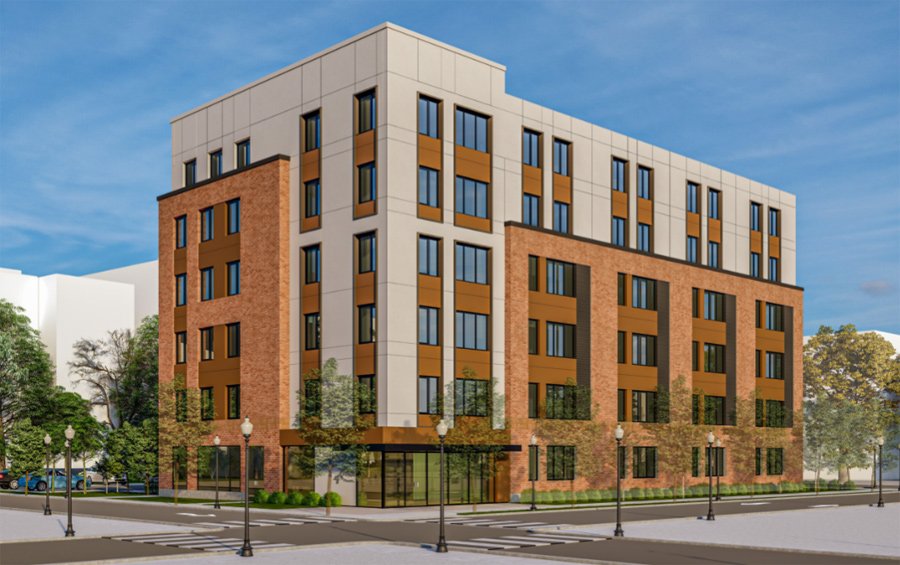
Rendering by DREAM Collaborative.
Related Beal and DREAM Development have filed plans for a six-story, 45-unit condo building on what is now a Boston Water and Sewer Commission parking lot on Reed Street between East Lenox and Newcomb streets on the Roxbury/South End line.
The building, in which all units will be sold to people making no more than 80% or 100% of the Boston area median income, is the first of what would eventually be a five-building, 402-unit complex by 2030. The developers filed for this specific building now because part of its financing will come from federal Covid relief funds that require designation by year's end or the money goes away.
All of the buildings will sit on land that the then BRA took by eminent domain as part of a South End urban-renewal project in 1975 that forced the eviction of thousands of residents. The parking-lot sites, more than four acres stretching to Harrison Avenue and Melnea Cass Boulevard, then never had anything built on them and so have served as weekday car storage for decades.
The units in the new building would be split between sixteen studios, twelve one-bedroom, twelve two-bedroom and five three-bedroom units, according to the developers' filing.
The proposed building would have 32 parking spaces, initially in one of the remaining BWSC lots, eventually in a parking lot or garage to be built as part of future development. The building would have indoor storage for 54 bicycles.
Construction is planned to start in mid-2025, with completion by the end of 2026.
In addition to use of high-efficiency heating, air conditioning and water systems, the building will also be designed to resist increasingly bad storms as temperatures can rise. Living space and critical building utilities will all be located above anticipated future flooding levels, while landscaped areas around the building will double as both attractive amenities and "as stormwater management solutions and potential soft barriers" against flooding.
Like the job UHub is doing? Consider a contribution. Thanks!
Ad:
Comments
Hmmm
By Anon
Wed, 09/11/2024 - 1:05pm
Where will the money come from when even market-rate developments don't pencil out most of the time?
There are programs ...
By adamg
Wed, 09/11/2024 - 1:15pm
That can help fund affordable housing. In this specific case, one is City Hall deciding to spend a fairly large chunk of ARPA Covid-relief funds on housing (and, yes, the rules for the money says they can do this). There are also state grant funds and tax breaks.
Spread of COVID was housing driven
By SwirlyGrrl
Wed, 09/11/2024 - 1:25pm
Housing conditions - crowding, poor air quality, etc. drove COVID along with other structural factors related to housing. This is why those funds can be spent on improving housing quality and affordability.
How much was Covid mortality
By Frelmont
Wed, 09/11/2024 - 9:01pm
How much was Covid mortality driven by (well, not held at bay as well as it might have been) forcing people into restaurant kitchens and not having a better controlled food distribution system?
Listening to the President of the Restaurant Association on Boston Public Radio some years ago I got the distinct impression the strategy was to keep kitchen workers in the dark and put them at exquisite risk to bringing SARS-CoV-2 home to their families. I mean, we know this and we have some language around “disparities,” but these folks lives were “spent” like soldiers marched into battle- “acceptable losses,” and I don’t hear this language in our reckoning.
To this day - I imagine - there hasn’t been a transparent, public after action with minutes and all. Did we right-size the response pre-phasing and phasing to minimize morbidity and mortality, or were there an overabundance of winners chosen at the expense of lives? How was the line drawn between protecting the maximum number of lives at any expense, and keeping Ma functioning and maintaining civil order?
Check out the surveys
By SwirlyGrrl
Thu, 09/12/2024 - 8:38pm
There is some data here about the lived experiences of people across the Commonwealth, with oversampling of vulnerable groups.
https://www.mass.gov/info-details/covid-19-communi...
Don't think it answers all your questions, but there is some info in this.
All affordable is great!
By epeemike81
Wed, 09/11/2024 - 1:11pm
One question, though: Is the whole complex going to be all affordable, or just the first building and the other 4 will be market rate?
TBC: build it either way! I'm just curious.
If they're done like projects on other city-owned parcels ...
By adamg
Wed, 09/11/2024 - 1:19pm
Then the majority of the units will have to be affordable - the city is giving developers land at way, way reduced prices in exchange for building up the city's supply of affordable housing.
Caveat: The projects I'm familiar involve vacant lots (and parking lots) directly owned by the city of Boston in places like Nubian Square and Dorchester, sold to developers by the Mayor's Office of Housing
This one's a bit different because the BPDA (OK, now the Boston Planning Department) is involved - and the land is under the control of the BWSC, which, like the old BPDA, is a quasi-independent authority.
The BPDA granted development rights to the parking lot to the two developers in April. Their proposal calls for a long-term total of 402 "affordable and workforce" housing units. "Workforce" housing is also income-restricted, but up to 120% of the Boston-area median income, as opposed to "affordable" housing, which is typically 70% or 80% for apartments and up to 100% for condos.
Not what was originally proposed
By Bostoneer
Wed, 09/11/2024 - 8:53pm
This plot originally was proposed to have a much larger building and an actual park at the corner, now it is a much smaller building and parking instead. Stop the bait and switches!
Add comment